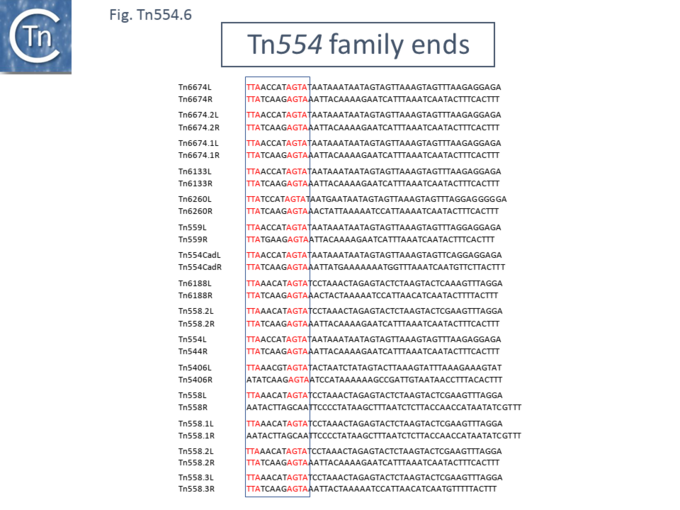Transposons families/Tn554 family
Contents
- 1 Historical
- 2 Diversity and Distribution
- 3 Tn554 organisation and expression of transposition-related genes.
- 4 Transcription
- 5 Mutational analysis of tnpA, B and C
- 6 Relationship of TnpA and TnpB to tyrosine recombinases
- 7 Tn554 family ends
- 8 Insertion
- 9 Circular Transposon forms
- 10 Mechanism.
- 11 Acknowledgements
- 12 Bibliography
Historical
Tn554 was originally identified in Staphylococcus aureus as a determinant specifying spectinomycin resistance and inducible erythromycin (macrolide-lincosamide-streptogramin B (MLS)2) which was able to establish by transduction in a rec-deficient host [1] and was later recognized as a transposon [2]. Early genetic studies with a chromosomally located copy suggested that it might undergo site-specific integration on transduction since it appeared to be linked to specific chromosomal markers [2]. Moreover, when inserted into a plasmid, Tn554 it could be transferred alone during transduction, without the accompanying plasmid markers implying transposition from the plasmid vector into the transducing phage [3]. The observation that its transduction frequency was extremely high compared to other markers but was dramatically reduced if the recipient cell already carried a Tn554 copy in its chromosomal site led to the idea that its activity was regulated by a repressor [3][4] although it is possible that this was due simply to the occupation of the primary Tn554 integration site. It was also observed that in cases where the entire Tn554-carrying plasmid was introduced either by transduction or transformation, a copy of the transposon could often be found in the recipient chromosome, suggesting some form of zygotic induction [5] occurred from the plasmid when introduced into naïve cells [6]. Southern hybridization of restriction digested genomic DNA from 15 different Staphylococcus strains from a number of sources using radioactive labelled Tn554 DNA clearly revealed the presence of a Tn554 copy at the same location, and in one case, an additional copy was present [6]. Site-specific insertion was confirmed using a plasmid target with a clone site [4] and using this system, it was also shown that insertions could occur into secondary sites at a lower frequency. Electron microscopy heteroduplex (see General Information/IS History) analysis between plasmids with and without a Tn554 insertion revealed a single strand Tn554 insertion loop.
The fact that when introduced into a second strain, the Tn554-carrying plasmids did not change (i.e. retained the transposon) while Tn544 transposition into the chromosome had occurred, suggested that transposition in this case may be replicative [4]. However, this is certainly not a formal demonstration of replicative transposition, especially in view of the possibility that transposition appears to occur by site-specific excision of a circular transposon copy and subsequent site- specific integration. This must be revisited using more powerful biochemical approaches. Transposition of Tn554 from secondary insertion sites in a number of plasmids occurred exclusively into the chromosomal site but at quite variable frequencies depending on the plasmid and site.
The location of the Tn554 antibiotic resistance genes to the right end of the transposon was identified by restriction fragment cloning while a possible transposition repressor tnpI was identified by its ability to inhibit transposition of an incoming Tn554 copy and localized to the left end [7]. Although the nature of tnpI remains obscure, it was shown that it resides in the left end within the first 89 bp and can act in trans leading to the proposal that this region may contain a binding site which titrates one of the transposition proteins [7]. Moreover, the nucleotide sequences of the Tn554 junctions (three 'primary' and two 'secondary' insertions) revealed that Tn554 does not include terminal Inverted Repeats (IR) at its ends neither does it generate Direct target Repeats (DR) typical of many other transposons and insertion sequences [8]. Insertion occurred specifically between two A residues at the primary insertion site with the transposon in the same orientation [8].
The entire Tn554 nucleotide sequence, 6,691 bp [9], revealed six open reading frames named from left to right (Fig. Tn554.1 A), tnpA, tnpB, tnpC, three transposition-related genes, the antibiotic resistance genes: the spc determinant, an adenyltransferase, AAD(9), that modifies spectinomycin but not streptomycin and ermA, followed by a SAM-dependent acetyl transferase [9] (Fig. Tn554.1 A).
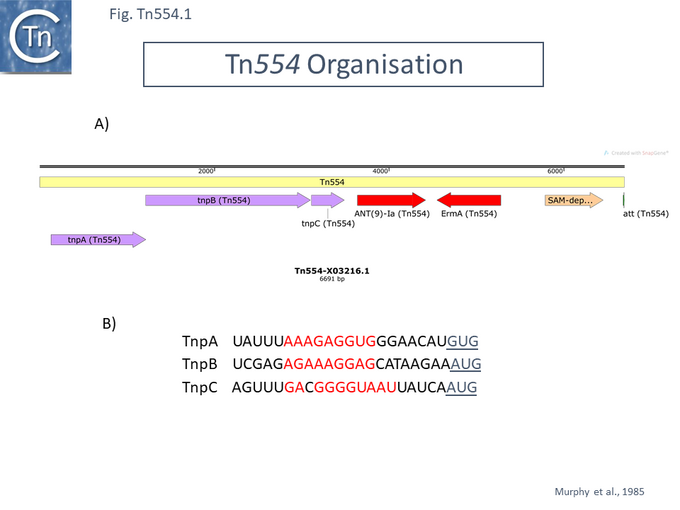
Diversity and Distribution
A limited number of Tn554 family members have now been identified and all are restricted to the Firmicutes but are widely present in many different strains. In particular, the Staphylococci, Enterococci, Listeria and Bacillus ((Fig. Tn554.2). They are all organised in a similar way with the transposition genes located at the left end and a variety of AMR genes located to the right. These include: aad (aminoglycosides), ermA (macrolide, streptogramin, lincosamide), a SAM-dependent acetyl transferase, fexA (phenicol antibiotic efflux pump), dfK (trimethoprim resistant dihydrofolate reductase), vgaALC and vgaE (streptogramin, pleuromutilin, lincosamide, oxazolidinone, tetracycline, phenicol), qac (small multidrug resistance (SMR) fluoroquinolone efflux pump), lnuG: (lincosamide) and optrA (oxazolidinone, macrolide, tetracycline); as well as a number of other passenger genes: fla (flavodoxin), mobC (conjugative relaxase) and an araC family transcriptional regulator family. One derivative of Tn558 (Tn558.1, AM408573.1) carries an insertion of an ISSau9-based compound transposon, TnSau9 including lsaA (macrolides, tetracycline, lincosamide, pleuromutilin, phenicol, oxazolidinone, streptogramin) and cfrA (23S ribosomal RNA methyltransferase conferring resistance to phenicol, oxazolidinone, streptogramin, lincosamide and pleuromutilin) inserted into the tnpC gene.
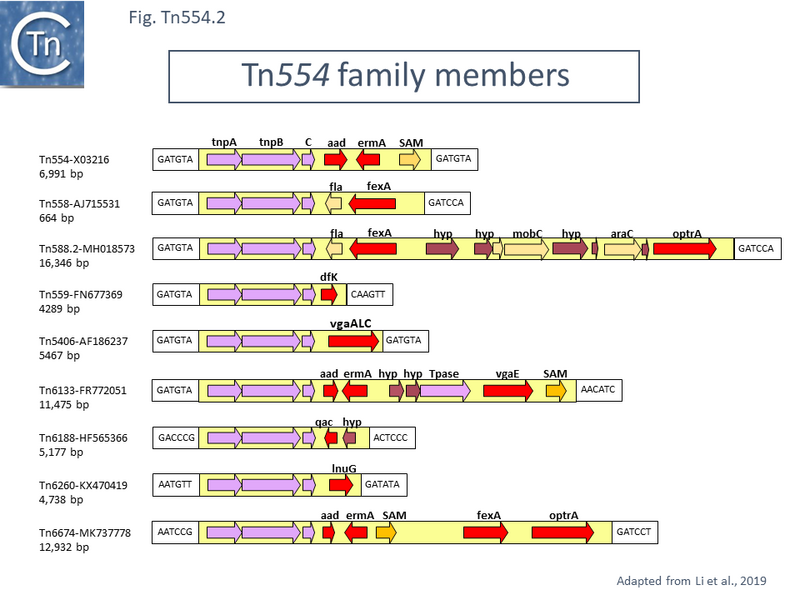
An additional variant, Tn554Cad (AM904731), was also identified in a chromosomal SCCmec cassette of Staphylococcus aureus 85/2082 [10] and is well represented in different strains in the public sequence databases. It carries three Cadmium resistance genes involved in sequestration and export but lacks tnpA.
A phylogenetic tree (Fig. Tn554.3) based on concatenated TnpA and TnpB amino acid sequences. divides this small group into two subgroups one of which include Tn558 and its two derivatives.
This can also be seen in comparing and alignment of the individual the individual Tnp proteins, in particular TnpB and TnpC (Fig. Tn554.4 A, B and C) and is reinforced by inspection of the ends of the “core” transposon (without its accompanying att site; see below; Fig. Tn554.6)
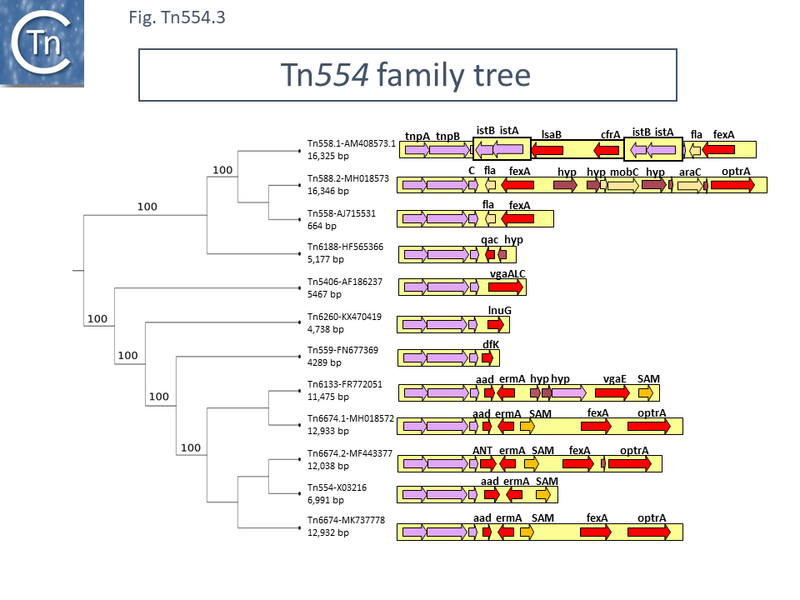
The three Tn554 transposition-related genes tnpA, tnpB, tnpC, specify proteins of 361, 630 and 125 amino acids respectively. They are all expressed from left to right ((Fig. Tn554.1 A) with overlapping TnpA and TnpB termination and initiation codons (ATGA) implying a translation coupling between the two [9]. However, both tnpA and tnpB carry potential (extended) gram positive ribosome binding sites ((Fig. Tn554.1 B).
Transcription
Transcription studies using northern blot analysis of total RNA and labelled DNA probes specific for each orf suggested that tnpA may be transcribed independently. Two major tnpA-specific RNA species were observed of approximately 1150 and 1250 nucleotides together with a number of minor species (800, 1000 and 1425 bases). No tnpA transcript large enough to include both tnpA and tnpB could be observed [9]. A tnpB-specific probe revealed only a diffuse signal rather than specific well-defined species which a tnpC-specific probe showed very low levels of a diffuse signal. Using an in vitro transcription/translation system, the only transposition-related protein observed was TnpA [9].
Mutational analysis of tnpA, B and C
A number of transposition defective Tn554 mutants were also isolated and analysed [9]. They fell into all three groups corresponding to the three tnp reading frames. Further genetic analysis [11] showed that mutations in each of the Tn554 orfs could be complemented in trans by cloned copies of the corresponding wildtype DNA fragments containing the particular gene. The product of tnpC was not absolutely required for transposition since mutants in which of most of the tnpC gene had been deleted retained 2% transposition activity compared to the wildtype transposon [11]. Interestingly, this mutation affected the orientation of Tn554 insertion (see below).
Relationship of TnpA and TnpB to tyrosine recombinases
It has been suggested that TnpA and TnpB are both members of the Int family of tyrosine site-specific recombinases. This is based on the similarity of a short consensus sequence including three key amino acids, HXXR…….Y, involved in catalysis and located near the C termini (Fig. Tn554.5 A). The figure shows an alignment of TnpA, TnpB (from all available Tn544 family members) and a number of representative tyrosine recombinases. For TnpA, the identities occur within the C-terminus whereas TnpB includes a C-terminal extension following the recombinase motif (Fig. Tn554.5 B).
Tn554 family ends
In general, Tn554 family members are represented with a hexanucleotide att sequence attached to the right end. This is involved in excision and integration of the transposon (see below). Examination of the sequence of the “core” transposon ends with att removed, reveals that left and right ends do share a certain degree of inverted sequence identity (Fig. Tn554.6) which is common to the majority of family members including the unusual Tn554Cad copy. The right ends of three members, Tn5046, Tn558 and Tn558.1 do not conform to this pattern although their left ends do. In the case of Tn5046, the expected 5’ T is replaced by A which might simple reflect a mutation of the terminal base pair. However, the right end of the other two bears little resemblance to the expected sequence, an observation which could indicate that the reported end is incorrect. Indeed, a Tn558 derivative, Tn558.3, from Bacillus sp. HBCD-sjtu (CP025122) which is almost identical to Tn558 (AJ715531), carries typical Tn554 family left and right ends (Fig. Tn554.6) implying that a post-insertion rearrangement affecting the right end had occurred in Tn558 (AJ715531) and that Tn558.1 (AM408573) was subsequently generated from this copy by insertion of a compound transposon (Fig. Tn554.3).
Insertion
The primary insertion site of Tn554 family members is located in a host DNA repair gene, radC (Fig. Tn554.3). This has been observed for all members investigate and includes Tn554 itself as well as Tn558 [12] (AJ715531) carried by plasmid pSCFS2 in Staphylococcus lentus, Tn559 [13] (FN677369), Tn5406 [14] (AF186237) and Tn6133 [15] (FR772051) both from Staphylococcus aureus, Tn6188 [16] (Listeria), Tn6260 [17] and Tn6674 [18] (Enterococcus) Fig. Tn554.7 and Fig. Tn554.8). This is also the case for Tn554Cad in the isolate found in Staphylococcus aureus strain JKD6009 (LR027876) and other examples.
The sequence of the “core” primary target site of Tn554 (attTn554) was determined to be the highly conserved hexanucleotide, 5-GATGTA-3 [2][8][19][20][21]. While Tn554 insertion occurred in only one orientation (+) into the chromosomal site (Fig. Tn554.3), insertion into an attTn554 site (and its flanking DNA) cloned into a suitable vector plasmid was observed to occur in both orientations [8]. However, most plasmids with insertion in the ‘+’ orientation were unstable (in contrast to those in the chromosome), giving rise to deletion products while plasmids with insertion in the opposite, ‘-‘, orientation were stable. The underlying reason for this was unclear: the authors state that they were unable to clone the target-carrying DNA fragment itself in the opposite orientation in the vector plasmid and that results using a strain deleted for the chromosomal target site suggest that instability was due to recombination although these results are not reported [8].
As indicated above, mutants in which of most of the tnpC gene had been deleted retained 2% transposition activity compared to the wildtype transposon [11]. However, such mutations were observed to affect the insertion orientation and this was dependent on the Tn554 orientation in the donor molecule. This was revealed using two temperature sensitive plasmids with an identical chromosomal attTn554 sequence together with flanking DNA which had each received a Tn554 insertion, one in the ‘+’ (wildtype) orientation and the other in the ‘-‘ orientation. The same tnpC deletion was introduced into each transposon and transposition into the chromosomal attTn554 site was scored at high temperature with appropriate antibiotic resistance screening. It was observed that insertions from the Tn554 ’+’ donor gave rise exclusively to insertions in the ‘+’ orientation while those from the Tn554 ‘-‘ donor generated insertions in the ‘-‘ orientation [11]. Furthermore, a mutant lacking the carboxy-terminal 59 residues of TnpB also exhibited altered insertion orientation. suggesting that TnpC is required for correct orientation of the element upon insertion and that this protein may interact with the carboxy-terminal portion of the TnpB to be fully functional [11].
Analysis of the attTn554 sequence itself by sequential deletion [20] revealed that sequences adjacent to the core were required for target activity. Deletions removing DNA further than about 20 bp from the left (5’) and 10 bp from the right (3’) core end (light grey squares; Fig. Tn554.7) significantly reduced activity while deletions further than 7bp from either side (dark grey squares; Fig. Fig. Tn554.7) eliminated target capacity.
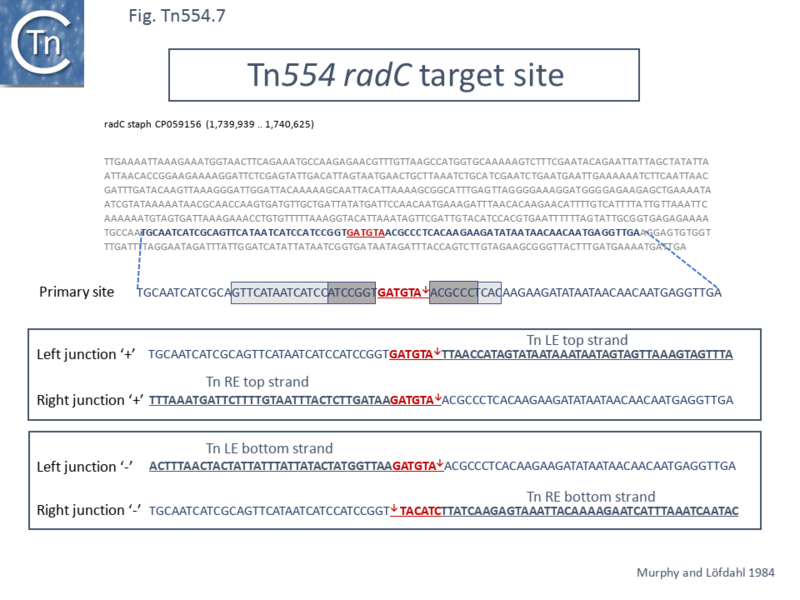
A survey of Tn554 family transposons in a number of different Firmicutes (Fig. Tn554.8)[16] showed remarkably, both at the protein (Fig. Tn554.8 A) and DNA (Fig. Tn554.8 B ) levels, that in spite of DNA sequence variation, insertion occurred at precisely the equivalent position in all examples analysed.
Tn558 (AJ715531), Tn5406 (AF186237) also uses attTn554 [14]. In certain examples (e.g. Tn6133 [15]) the attTn554 site in radC is still used and appears at the Tn left end, but the sequence at the right end is inverted. This has also been noted for Tn554 variants [19] and was explained as resulting from transposition of a transposon which had previously undergone insertion in the “-“ orientation and subsequently re-transposed into a primary site (accompanying att sites proposed are shown in Fig. Tn554.3)
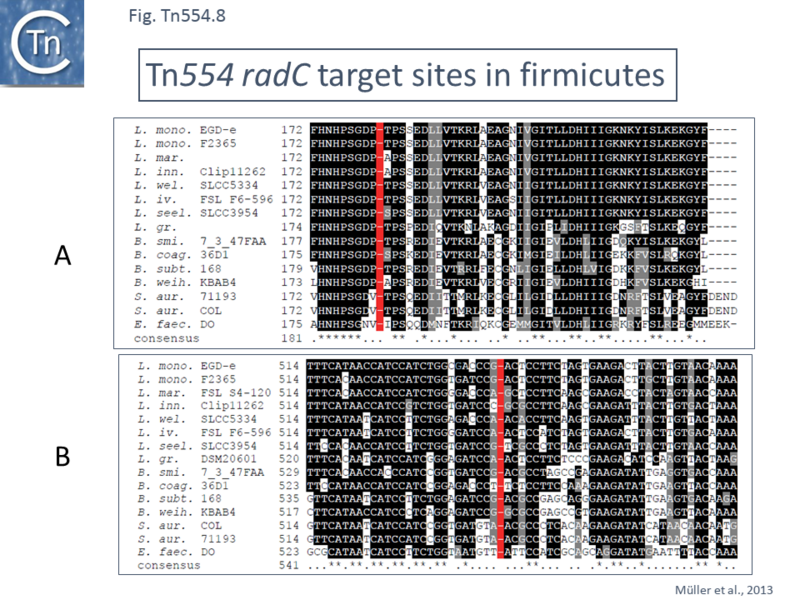
Circular Transposon forms
Several studies have revealed that Tn554 family members can be found as circular forms (Fig. Tn554.9) as judged by the presence of a junction containing left and right transposon ends identified using so-called “reverse” PCR using primers directed outwards from the transposon. This approach detects left-right junction fragments of the transposon which is generally taken as support for the presence of circular transposon copies but does not, on its own, formally rule out directly repeated tandem duplication as found, for example, for IS21 in transformation of R68 to R68.45 [22][23][24] allowing the plasmid to integrate into the host chromosome and promote polarised Hfr chromosome transfer [25].
These include: Tn5406 (AF186237) [14], Tn558 where the amplicon fragment included the 6bp core sequence originally located at the left end border as a spacer between the abutted left and right ends [12][26]; and Tn559 [13] where the amplicon fragment again included the original left-end 6bp core sequence, Tn6674 (MK737778) [18] and Tn6133 [15].
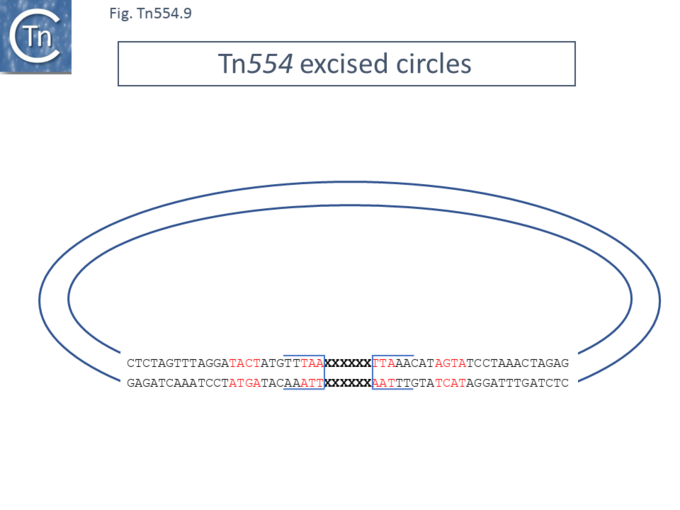
Mechanism.
Early studies led to the idea that Tn554 transposition might resemble a bacteriophage lambda integration. This notion, derived from observation of the sequence-specificity of insertion together with the sequence of the left and right Tn junctions (Fig. Tn554.7), the presence of Tn circles with a spacer with the sequence of the core att site (Fig. Tn554.9) and the fact that both TnpA and TnpB exhibit motifs similar to the catalytic motifs of Tyrosine site-specific recombinases (Fig. Tn554.5 A). The recombination mechanism involved in excision and insertion, whether excision is conservative or, as has been suggested, replicative, the respective roles of TnpA and TnpB in this, the way in which TnpC may intervene in assuring a “correct” insertion orientation all need to be addressed using more biochemical and structural approaches.
Acknowledgements
We would like to thank Stephan Schmitz-Esser for kind permission to use Fig. Tn554.8.
Bibliography
- ↑ Wyman L, Goering RV, Novick RP . Genetic control of chromosomal and plasmid recombination in Staphylococcus aureus. - Genetics: 1974 Apr, 76(4);681-702 [PubMed:4275652] [DOI]
- ↑ 2.0 2.1 2.2 Phillips S, Novick RP . Tn554--a site-specific repressor-controlled transposon in Staphylococcus aureus. - Nature: 1979 Mar 29, 278(5703);476-8 [PubMed:156306] [DOI]
- ↑ 3.0 3.1 Novick RP, Khan SA, Murphy E, Iordanescu S, Edelman I, Krolewski J, Rush M . Hitchhiking transposons and other mobile genetic elements and site-specific recombination systems in Staphylococcus aureus. - Cold Spring Harb Symp Quant Biol: 1981, 45 Pt 1;67-76 [PubMed:6271492] [DOI]
- ↑ 4.0 4.1 4.2 4.3 Murphy E, Phillips S, Edelman I, Novick RP . Tn554: isolation and characterization of plasmid insertions. - Plasmid: 1981 May, 5(3);292-305 [PubMed:6267632] [DOI]
- ↑ JACOB F, WOLLMAN EL . [Processes of conjugation and recombination in Escherichia coli. I. Induction by conjugation or zygotic induction]. - Ann Inst Pasteur (Paris): 1956 Oct, 91(4);486-510 [PubMed:13373067]
- ↑ 6.0 6.1 Krolewski JJ, Murphy E, Novick RP, Rush MG . Site-specificity of the chromosomal insertion of Staphylococcus aureus transposon Tn554. - J Mol Biol: 1981 Oct 15, 152(1);19-33 [PubMed:6279864] [DOI]
- ↑ 7.0 7.1 Murphy E . Inhibition of Tn554 transposition: deletion analysis. - Plasmid: 1983 Nov, 10(3);260-9 [PubMed:6318247] [DOI]
- ↑ 8.0 8.1 8.2 8.3 8.4 Murphy E, Löfdahl S . Transposition of Tn554 does not generate a target duplication. - Nature: 1984 Jan 19-25, 307(5948);292-4 [PubMed:6320000] [DOI]
- ↑ 9.0 9.1 9.2 9.3 9.4 9.5 Murphy E, Huwyler L, de Freire Bastos Mdo C . Transposon Tn554: complete nucleotide sequence and isolation of transposition-defective and antibiotic-sensitive mutants. - EMBO J: 1985 Dec 1, 4(12);3357-65 [PubMed:3004956] [DOI]
- ↑ Ito T, Katayama Y, Asada K, Mori N, Tsutsumimoto K, Tiensasitorn C, Hiramatsu K . Structural comparison of three types of staphylococcal cassette chromosome mec integrated in the chromosome in methicillin-resistant Staphylococcus aureus. - Antimicrob Agents Chemother: 2001 May, 45(5);1323-36 [PubMed:11302791] [DOI]
- ↑ 11.0 11.1 11.2 11.3 11.4 Bastos MC, Murphy E . Transposon Tn554 encodes three products required for transposition. - EMBO J: 1988 Sep, 7(9);2935-41 [PubMed:2846290] [DOI]
- ↑ 12.0 12.1 Kehrenberg C, Schwarz S . Florfenicol-chloramphenicol exporter gene fexA is part of the novel transposon Tn558. - Antimicrob Agents Chemother: 2005 Feb, 49(2);813-5 [PubMed:15673776] [DOI]
- ↑ 13.0 13.1 Kadlec K, Schwarz S . Identification of the novel dfrK-carrying transposon Tn559 in a porcine methicillin-susceptible Staphylococcus aureus ST398 strain. - Antimicrob Agents Chemother: 2010 Aug, 54(8);3475-7 [PubMed:20498309] [DOI]
- ↑ 14.0 14.1 14.2 Haroche J, Allignet J, El Solh N . Tn5406, a new staphylococcal transposon conferring resistance to streptogramin a and related compounds including dalfopristin. - Antimicrob Agents Chemother: 2002 Aug, 46(8);2337-43 [PubMed:12121902] [DOI]
- ↑ 15.0 15.1 15.2 Schwendener S, Perreten V . New transposon Tn6133 in methicillin-resistant Staphylococcus aureus ST398 contains vga(E), a novel streptogramin A, pleuromutilin, and lincosamide resistance gene. - Antimicrob Agents Chemother: 2011 Oct, 55(10);4900-4 [PubMed:21768510] [DOI]
- ↑ 16.0 16.1 16.2 Müller A, Rychli K, Muhterem-Uyar M, Zaiser A, Stessl B, Guinane CM, Cotter PD, Wagner M, Schmitz-Esser S . Tn6188 - a novel transposon in Listeria monocytogenes responsible for tolerance to benzalkonium chloride. - PLoS One: 2013, 8(10);e76835 [PubMed:24098567] [DOI]
- ↑ Zhu XQ, Wang XM, Li H, Shang YH, Pan YS, Wu CM, Wang Y, Du XD, Shen JZ . Novel lnu(G) gene conferring resistance to lincomycin by nucleotidylation, located on Tn6260 from Enterococcus faecalis E531. - J Antimicrob Chemother: 2017 Apr 1, 72(4);993-997 [PubMed:28039271] [DOI]
- ↑ 18.0 18.1 Li D, Li XY, Schwarz S, Yang M, Zhang SM, Hao W, Du XD . Tn6674 Is a Novel Enterococcal optrA-Carrying Multiresistance Transposon of the Tn554 Family. - Antimicrob Agents Chemother: 2019 Sep, 63(9); [PubMed:31209008] [DOI]
- ↑ 19.0 19.1 Chikramane SG, Matthews PR, Noble WC, Stewart PR, Dubin DT . Tn554 inserts in methicillin-resistant Staphylococcus aureus from Australia and England: comparison with an American methicillin-resistant group. - J Gen Microbiol: 1991 Jun, 137(6);1303-11 [PubMed:1655951] [DOI]
- ↑ 20.0 20.1 Murphy E, Reinheimer E, Huwyler L . Mutational analysis of att554, the target of the site-specific transposon Tn554. - Plasmid: 1991 Jul, 26(1);20-9 [PubMed:1658834] [DOI]
- ↑ Tillotson LE, Jenssen WD, Moon-McDemott L, Dubin DT. Characterization of a Novel Insertion of the Macrolides- Lincosamides-Streptogramin B Resistance Transposon Tn554 in Methicillin-Resistant Staphylococcus aureus and Staphylococcus epidermidis. Antimicrob Agents Chemother. 1989;33:541–550.
- ↑ Reimmann C, Haas D . Mode of replicon fusion mediated by the duplicated insertion sequence IS21 in Escherichia coli. - Genetics: 1987 Apr, 115(4);619-25 [PubMed:3034717] [DOI]
- ↑ Riess G, Holloway BW, Pühler A . R68.45, a plasmid with chromosome mobilizing ability (Cma) carries a tandem duplication. - Genet Res: 1980 Aug, 36(1);99-109 [PubMed:6777257] [DOI]
- ↑ Leemans J, Villarroel R, Silva B, Van Montagu M, Schell J. Direct repetition of a 1.2 Md DNA sequence is involved in site- specific recombination by the P1 plasmid R68. Gene. 1980;10:319–328.
- ↑ Willetts NS, Crowther C, Holloway BW . The insertion sequence IS21 of R68.45 and the molecular basis for mobilization of the bacterial chromosome. - Plasmid: 1981 Jul, 6(1);30-52 [PubMed:6269130] [DOI]
- ↑ Kehrenberg C, Ojo KK, Schwarz S . Nucleotide sequence and organization of the multiresistance plasmid pSCFS1 from Staphylococcus sciuri. - J Antimicrob Chemother: 2004 Nov, 54(5);936-9 [PubMed:15471995] [DOI]









